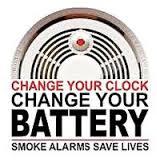SACRAMENTO – With Daylight Saving Time beginning on Sunday. Mar. 9, Cal Fire officials are reminding all Californians to ensure they have working smoke alarms in their homes.
Studies have shown that most homes have smoke alarms, however nearly two-thirds of home fire deaths result from fires in homes with no working smoke alarms.
“The time change is a great opportunity to spend a few minutes making sure our home’s smoke alarms are in good working conditions and installed in the proper locations,” stated California State Fire Marshal Tonya Hoover. “Most people know how critical smoke alarms are, but forget to maintain them.”
Working smoke alarms cut the risk of dying in home fires by half. With multiple types of smoke alarms, consumers must read the manufactures recommendations and properly place the alarms correctly. Smoke alarms should be placed inside and outside of every bedroom and on every level of the home.
With two different types of smoke alarm technologies on the market, Cal Fire recommends that every residence be equipped with both ionization and photoelectric smoke alarms. Many brands also offer dual sensor smoke alarms, which contain both ionization and photoelectric smoke sensors.
For years fire officials have asked homeowners to replace the batteries in their smoke alarms annually, but a recent law in California requires new smoke alarms to be equipped with a 10-year long-life lithium battery that doesn’t need to be replaced until the entire device is replaced after 10 years. It is still critical for residents to test their older alarms and replace old alkaline batteries annually.
Smoke alarm safety tips:
– Smoke alarms should be tested monthly using the test button to ensure they are operating correctly.
– Properly install and maintain smoke alarms both inside and outside of sleeping areas and on every level of your home.
– Replace older alarm’s alkaline batteries every year, or when the alarm signals (“chirps”) the end of the battery life. If you don’t know the battery type – check and replace.
– Inspect, test and clean smoke alarms at least once every year.
– Replace the smoke alarm itself at least every ten years.
– Interconnected smoke alarms are best, because if one sounds, they all sound.
– Use both ionization and photoelectric smoke alarms or dual sensor smoke alarms.
– Never paint over a smoke alarm.
– Practice exit drills so everyone understands what to do when they hear a smoke alarm.
For more information on smoke alarms, visit: http://www.fire.ca.gov/communications/communications_firesafety_smokealarms.php.




